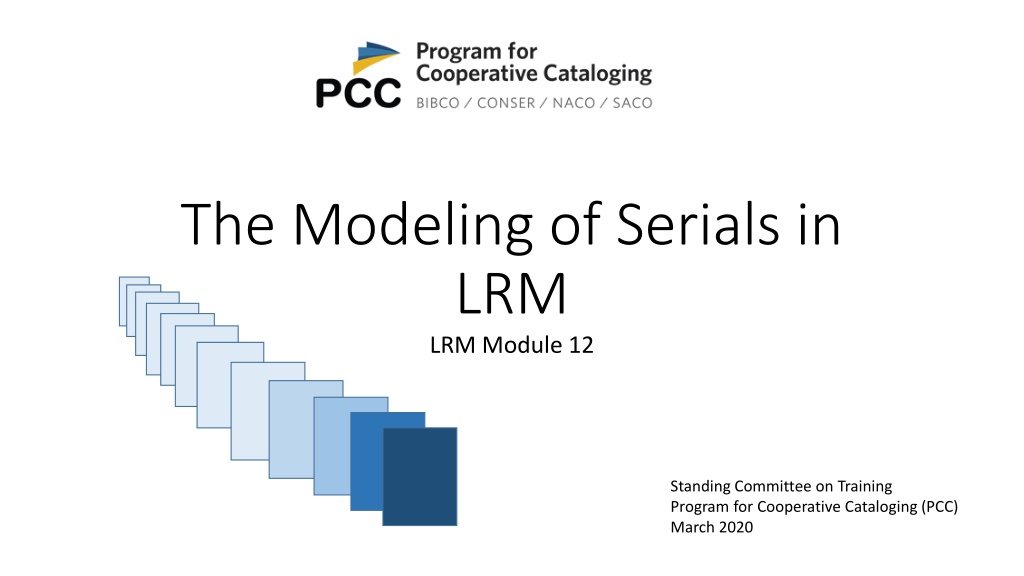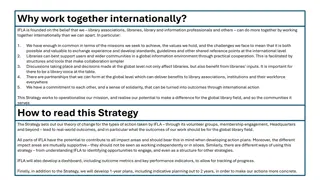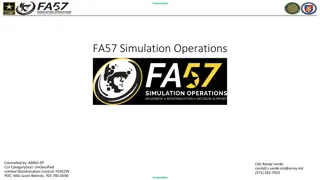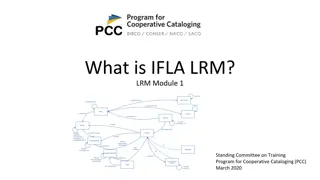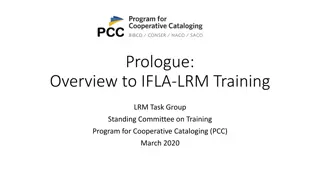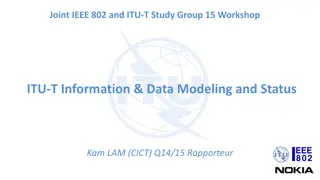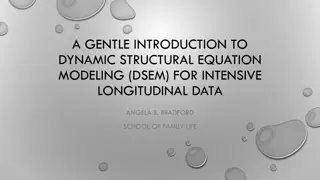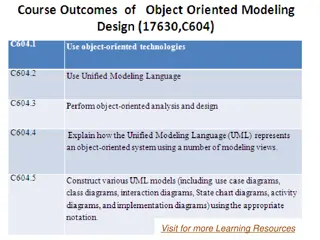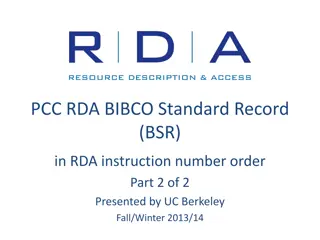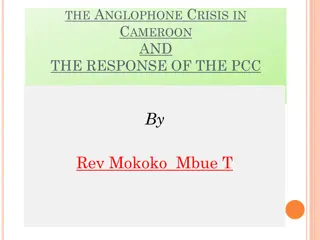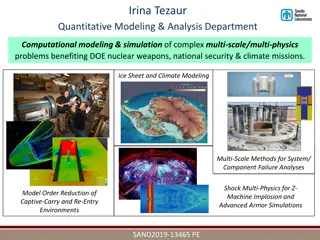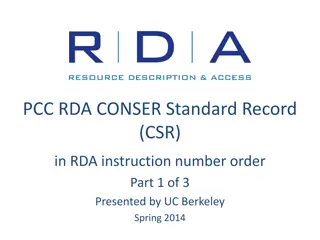Modeling of Serials in IFLA LRM Module 12 by PCC
Serials in library cataloging are modeled as complex constructs in IFLA LRM with considerations for whole/part and aggregation relationships. This module explores the intricacies of serial manifestations, issue manifestations, and the concept of WEM lock, providing insights into collocating closely-related serials and commonality of content. Understanding the essence of serials as aggregating works and the role of a serial work in aggregation is key in library cataloging practices.
Download Presentation

Please find below an Image/Link to download the presentation.
The content on the website is provided AS IS for your information and personal use only. It may not be sold, licensed, or shared on other websites without obtaining consent from the author.If you encounter any issues during the download, it is possible that the publisher has removed the file from their server.
You are allowed to download the files provided on this website for personal or commercial use, subject to the condition that they are used lawfully. All files are the property of their respective owners.
The content on the website is provided AS IS for your information and personal use only. It may not be sold, licensed, or shared on other websites without obtaining consent from the author.
E N D
Presentation Transcript
The Modeling of Serials in LRM LRM Module 12 Standing Committee on Training Program for Cooperative Cataloging (PCC) March 2020
Learning Outcomes At the end of this module, you will be able to: Understand how serials are modeled in IFLA LRM Understand commonality of content in serials Understand the meaning of WEM lock and its ramifications for collocating closely-related serials 2
How does LRM model serials? Serials are complex constructs that combine whole/part relationships and aggregation relationships The serial manifestation has a whole/part relationship with the individual issue manifestations that are published over time (even when just one issue is ever published) Each issue manifestation is an aggregate*manifestation (even though the aggregating expression involved may occasionally aggregate a single expression) *See modules 10-11 for the modeling of aggregates in LRM 3
Is the serial as a whole also an aggregate? Yes, in that the resulting manifestation is issued in parts over time and embodies expressions of distinct works as well as an expression of an aggregating work, which provides the plan for the aggregation. We call this particular overall aggregating work a serial work. Note: This usage differs from common library usage. In LRM a serial is a kind of aggregating work. In common library usage a serial is the manifestation embodying (a) an expression of that aggregating work and (b) expressions of all the distinct works that have been aggregated. The serial work provides the plan for the aggregation of the serial as a whole and also inspires the plan for the aggregation of an individual issue. 4
Commonality of content in serials IFLA LRM defines a work as having a certain commonality of content among its expressions For monographs, this refers to the content common to the expressions of a work For serials (a special case of aggregating work), however, the commonality of content resides in both the publisher s and editor s intention to convey the feeling to end users that all individual issues belong to an identifiable whole, and in the collection of editorial concepts (a title, an overall topic, a recognizable layout, a regular frequency, etc.) that will help convey that feeling. 5
Serials as Aggregate Works Recall that in the modeling of aggregates, the aggregating work is restricted to the right side of the diagram. It is not the manifestation at the bottom or the aggregated expressions on the left. The serial work is a special case of aggregating work, one in which the parts of the resulting manifestation are issued over time. This means the plan of a serial work may change over time 6
Serials change over time: North County Times North County Times (merger of North County Blade-Citizen and Escondido Times-Advocate) [1995-2012] followed by U-T North County Times (following purchase by U-T San Diego) [2012-2013] followed by U-T San Diego (North County edition) [2013] Did it become an expression of U-T San Diego? No: Different aggregated content = different work 7
Serials change over time: The Economist Originally there was a single edition published for a UK audience Eventually, overseas subscribers received an airmail version printed on onionskin paper A variant is now printed in North America that gives precedence to the US news section, omits some UK news stories, and occasionally has a different cover for marketing purposes There are also now seven international production sites that may occasionally print copies with region-specific covers for marketing purposes The website, however, presents all content combined The iPad app can be customized by region and includes downloadable audio human, not machine for the textual content Different aggregated content = different work 8
Serials change over time: Nature Print version Online version was originally PDFs of print pages via content aggregators Publisher s online version now includes: Flexible presentation of content Online-first content Article links to related content, references Extended data figures and tables, supplementary information, tables, etc. Integrated addenda, corrigenda, etc. Different aggregated content = different work 9
WEM (Work, Expression, Manifestation) lock Because serials may change over time, closely-related serials language editions, special audience editions, special format editions may diverge or converge over time to such an extent that they become distinct works (see previous Nature example). For this reason, LRM models each serial from the beginning as a distinct work, realized in a single expression and embodied in a single manifestation. This is known as a WEM lock . 10
Collocating of closely-related serials The WEM lock creates challenges for collocating closely-related serials. Serials that were related on the expression level in FRBR, are now often separate works LRM asserts that its model can be expanded by defining additional entities for groups of closely-related serials Example: the ISSN-L might be defined as an entity for relating serials in different formats. (The ISSN-L, or linking ISSN, is a specific ISSN that groups the different media versions of the same serial publication). 11
Relationships between serials LRM does not model relationships between serials as it does relationships between monographs Journals and cover-to-cover translation journals are not expressions of a common work Print and online versions of a journal are not expressions of a common work LRM models relationships between serials as work-to-work relationships LRM-R18 WORK has part WORK LRM-R19 WORK precedes WORK LRM-R20 WORK accompanies / complements WORK LRM-R22 WORK is a transformation of WORK (This encompasses most of the serial relationships recorded in MARC fields 760-787) 12
For more detailed information on modeling relationships As a high-level model, LRM refers users to PRESSOO or other models for more detailed modeling of relationships: Definition of PRESSOO : a conceptual model for bibliographic information pertaining to serials and other continuing resources / prepared by the PRESSOO Review Group (affiliated to the IFLA Cataloguing Section). Version 1.3 (August 2016) https://www.issn.org/wp-content/uploads/2017/05/pressoo_v1-3.pdf Note: In its modeling, PRESSOO uses an object-oriented formalism rather than an entity-relationship formalism like LRM 13
Relationship to other standards The LRM treatment of serials is compatible with their current treatment by: The ISSN Network The Program for Cooperative Cataloging (PCC) 14
Summary A serial is a special case of aggregate and should be understood in that context. A serial work is a type of aggregating work. For a serial, commonality of content refers to an intention to convey a feeling that a component belongs to an identifiable whole (the serial) as exhibited by various common features Because serials may change over time, editions may diverge or converge. Consequently, LRM models each serial as a unique work realized in a single expression that in turn is embodied in a single manifestation. This is called a WEM lock. Consequently, all relationships between serials are modeled as work-to-work relationships. LRM only defines these at the highest level Collocation of serials may be accomplished by defining additional entities in the model (e.g., ISSN-L to collocate serials in different formats) 15
